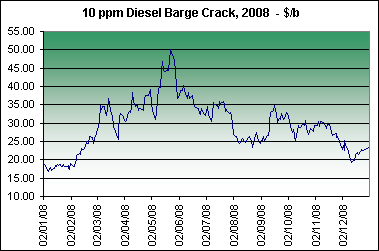Diesel moves to center stage for refiners
Diesel shared the steep climbs then precipitous falls of the rest of the oil complex in 2008, but the landmark transition for the driving fuel was its supplanting of gasoline as the defining component in the oil barrel (Podcast: 2008 a tumultuous year for European oil markets ).
Once the preserve of farmers, power generators and European motorists, diesel demand went global early on in 2008, as a strong pull of gasoil from the southern hemisphere combined with the steadily-climbing bedrock European diesel demand to leave much of the distillate markets short of product.
The move helped the diesel 10 ppm barge crack, a measure of a product's performance in relation to crude, to over $50/barrel at one point--record territory which helped comprehensively depose gasoline as the king of refinery margins.

The drivers behind the cataclysm that engulfed the gasoline market were the introduction of ever-greater quantities of ethanol and a rampant flat price, which kept US drivers away from the pumps, but the net impact utterly exploded the basic economic model that refiners had depended on for years.
That left middle distillates to shoulder the burden of refining margins, and diesel, with its year round demand, rapidly emerged as the consistent star performer.
Diesel begins its climb to record highs
"Who would have thought diesel could be sexy?" one distillate trader said early in the year, as Europe's unquenchable thirst marked the region out as the place to sell diesel.
As such, diesel's year unfolded in two distinct chapters--the
strength of crude forming the backdrop to a period of unprecedented
tightness that had brought significant volatility to diesel premiums
throughout the early part of the year, before rampant strength drew volumes
from across the world to Europe.
Beginning the year strongly, after a period of backwardation stretching from
October 2007 had kept storage levels low, 10 ppm barge values raced to a
premium of plus $77.50/mt over the front-month ICE gasoil contract by
mid-March, as the market felt the early effect of European turnaround season
and the loss of up to 1 million b/d of European refinery capacity.
The level heralded a period of sustained volatility, as premiums fluctuated
wildly over the course of the next three months, peaking at plus $69.25/mt
in late April, plunging to plus $16.75/mt by early May, before rebounding
suddenly to plus $64/mt by mid-May, according to Platts data.
European refinery capacity looked to be struggling to keep pace with the
continent's own demands, while the strength of diesel placed additional
burden on distillate-rich crude grades, further feeding the already
burgeoning strength of crude.
In flat price terms, the volatility met with the firming tone of ICE gasoil
contracts to send 10 ppm CIF NWE cargoes to $1,336.75/mt in late May, before
crude and ICE gasoils carried the assessment to $1,354.75/mt on July 11.
The strength was reflected at retail outlets across Europe, and end-users
and motorists took to the streets to show their dismay. Media reports
highlighted industry efforts to insulate itself from the full effect of
distillate values -- aircraft faced speed restrictions, buses had 'black
boxes' fitted to monitor fuel usage, and lorry drivers were offered
retraining on best driving practices to minimize fuel use.
Still farmers and fishermen marched on Brussels, road hauliers called for
government aid and mounted go-slow campaigns throughout the continent and,
as the cost of buying a 30,000 mt cargo of Mediterranean 50 ppm diesel
soared to nearly $41 million, 'credit' was the watchword that haunted the
trading activity for all market participants.
And then the banks began to fail.
Bear Sterns stumbled first and within weeks three of the world's biggest
investment banks were cut up, absorbed into others or gone, while others
emphatically cut back on their physical trading activity. The collapse sent
shockwaves across the markets.
Diesel shares crude's decline
The storm broke in late July, and for European diesel, the falling crude
values came as the supply situation rapidly improved.
From mid-June, the consistent trans-Atlantic supply showed in 10 ppm barge
premiums, emerging from the volatility to operate within a $10/mt band
around plus $25/mt throughout late June and much of July.
However, with the influx continuing into July and August, premiums begin to
creak as available product weighed heavily on values, ending a prolonged
period of backwardation and bringing incentive to store into August. That
switch brought some support, but still the trans-Atlantic flows continued as
traders saw no other outlet but Europe for US refiners.
Influx pulls diesel into storage
With an eye on the second expected European turnaround season from late
September, traders soaked up trans-Atlantic product and available storage
filled up quickly, forcing premiums to nose-dive, as the 10 ppm diesel barge
premium plunged to just plus $2.25/mt on August 22 on chronic oversupply.
Alongside that weakening, the flat price spiralled from its July high, to
return to levels seen at the beginning of the year by October, before
finally falling to levels below $500/mt by December 5, comprehensively
wiping away the gains of the last three years.
But for a brief rally on ICE gasoils on December 15, all diesel assessments
remained comfortably below $500/mt for the remainder of the year.
And yet diesel cracks remained strong performers, averaging around $25/b
throughout the year. Even under extreme pressure the diesel crack barely
slipped below plus $20/b and frequently operated at levels closer to plus
$30/b.
That strength meant refinery margins remained buoyant, particularly when
bolstered by unexpected strength in fuel oil or on the occasions when
gasoline hit par, encouraging refineries to run and exacerbating both diesel
and gasoline's oversupply by locking refinery output into a vicious cycle
that threatens to remain a factor through much of 2009.
|